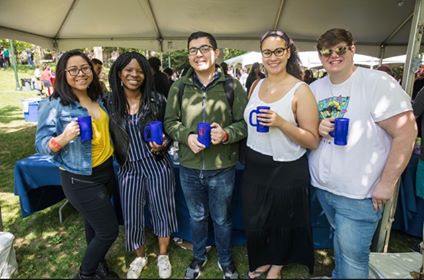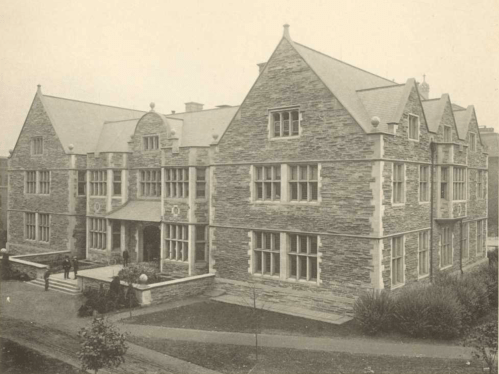By: Jorge Penado, C’19
International Relations Major
Work-Study Student, Sweeten Alumni House
- Aimlessly Walk Around Penn’s Campus: After years of our hard work of trying to get here, we can sometimes fail to live in the moment and soak in everything that Penn’s campus offers. We have the great fortune of attending a school that’s been around for nearly two hundred years that the nooks and crannies of this school are endless. Some of my best times were spent randomly walking around campus, initially to find that perfect study spot which I also recommend. But, walking around campus can come with various fun and exciting discoveries. Whether it’s the gargoyles perched on the Quad’s exterior or the graduate carousels in Fisher Fine Arts, there’s so much to find on this campus that it’s accumulated over years. Basically, what this lesson boils down to is that everyone should take a moment and realize that there’s so much around us that one can’t help but marvel at.

- Take Your Free Time Out of Left Field: While this may seem like a setup for a baseball reference, it’s actually much more the slang version. Many times, Penn students think that our extracurriculars have to strictly do with our studies or future career aspirations. But, sometimes you just want to do something you never could have imagined. If for some reason I traveled back in time to tell my high school senior self that I would be playing drums and making student short films as a kid interested in politics, I would have thought he was crazy. But, four years later, I’m glad I did those things because, one, they were beyond fun and, two, the stories and experiences are priceless. How else would I have known the commitment of a drum injury?
- Go Beyond Your Usual SEPTA Stops: The first part of this lesson is basically to use SEPTA. Maybe because I’m from the South where we don’t really have fully-developed subway systems, I fell in love with SEPTA, but in all honesty, you can’t experience Philly without it. It’s the veins of the city. Going beyond 40th westbound or 2nd eastbound was one of the coolest experiences that I’ve had because it felt like I wasn’t stuck in the “Penn Bubble.” Philly has so much to offer in every corner of the city whether it’s locally-owned restaurants in South Philly or the Ritz Theaters in Old City. As students in this city, we should do our part to explore beyond the main attractions, not to say that those aren’t amazing parts of Philly.
- Learn That Van Pelt Has The Extent of Human Knowledge: Alright, this might be a slight exaggeration, but the sentiment still remains. For some odd reason, I didn’t start using the library regularly until my Junior year, and boy was I missing out. Have you ever just walked through the aisles of Van Pelt? They have so much there to fill your time. From original Arabic manuscripts from the early Islamic periods to books on the role of satellite telecommunications during the Cold War, the diversity and extent of books in the library can sometimes become lost in the stress of our work. But, through my years, I’ve grown to appreciate the library for all its varied and helpful sources, and I encourage everyone to either begin to vehemently use those books or at least take a walk through the aisles to see what the production of academia around the world has produced.

- Find Those People You Can Talk To: While everyone says this, I can’t emphasize how important it is to make friends who you can trust and enjoy being around. One of my favorite parts of college has been getting to meet people from around the world and from such diverse sets of backgrounds. Before Penn, I was surrounded by people from my community who were largely similar. College gave me the opportunity to meet people from so many countries and learn about them. College also gave me the opportunity to get to know people more than I’ve ever gotten to know anyone. After living around them and going to classes with them, it’s inevitable that you’ll get to know people in ways you possibly never expected. I think that this is one of the best things about Penn and will remain one of the best for years after I graduate from school.
- Engage With The World Around You: Okay, I might be biased with this one because I’m an International Relations major, but I definitely think that my time at Penn allowed me to learn more about everything that’s happening around me. College is one of the first times when people are forced to talk about their thoughts and opinions on the world. By the world, I mean everything from complicated US politics to the historic movements in countries like Algeria and Sudan. The beauty of this is that everyone has thoughts on these issues, not just those studying them, and can hopefully teach you something new. I’ve had some of the best conversations about world affairs with computer science majors and gene editing with criminology majors. College is the time to learn about your place in the world. Read the newspaper. Have a conversation. Know what’s happening around you as a global citizen.

- Take The Time To Learn About Yourself: Your first thought may be, “What do you mean? I know who I am. I’m [insert name].” But, in the same vein as the previous lesson, I think college is the time to seriously learn about yourself. For many people, it’s the first time they’re not living at home and for many, it’s the first time moving far away. Four years ago, I moved over 1,550 miles and learned about myself in ways I could have never imagined. On an academic level, what kind of studier am I? What have been my favorite classes? Why? On a personal level, what kind of friend am I? How do I manage my time? What kind of things do I eat when no one’s telling me to eat healthily? So many things to learn about yourself with only four short years.
- Indulge In The Unusual & Particular: After seven lessons, it’s surprising how little I’ve spoken about academics. It’s what we’re here for in the first place! Though I came in knowing my general interests, I had absolutely no clue what subject matters I enjoyed the most. After spending my first two years taking intro courses and reading as much as I could, I began to realize that academia is filled with a bunch of people with specific interests that seem almost too narrow. But, the great thing about college is that nothing is too narrow to study. Everything that could possibly be studied has and will, so if there’s something that you enjoy, no matter how specific it seems, there’s room for it. As we try to balance majors for our long term goals with these interests, I definitely think there’s a way to do both, especially in these short years.
- Know That Everyone Is Just As Lost: When I first got to Penn, I can’t say that I wasn’t intimidated by the school and the people. In the beginning, I felt confused in every class, like an impostor in every seminar and beyond stressed for every test. On top of all of this, I thought I was the only one struggling. But, one of the most valuable things that I’ve learned at Penn is that everyone’s struggling in their own way. If Penn is a breeze for anyone, then more power to them, but I quickly realized that almost everyone questions whether they’re good enough. But, I learned that everyone has a place at Penn and that we should talk about it all. Penn became more enjoyable when I could speak to my friends about how stressful times can get. All of this is a normal part of college, and we shouldn’t fear being the only one going through it.

- Be Aware That Penn Was Made For You To Succeed: After all of these lessons, the one thing that I leave Penn knowing, and hope that every student can learn, is that Penn is made for the students. Though it may not feel like it when classes are stressful or you’re the first in your family to go to college, there are always people interested in seeing you succeed. Whether it’s the cultural houses, your major department or even just your peers, there’s a place for everyone and resources for anyone who asks for them. There’s money to fund your summer experiences. There are advisors to help you through your major. I know I have benefited significantly from being at Penn because I’ve always known there’s at least one person on my team. With this in mind, these four years at Penn can be much more endearing and fulfilling.


























